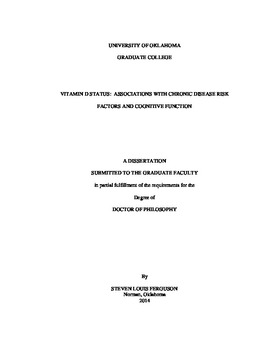| dc.description.abstract | Vitamin D deficiency and/or insufficiency is common in US adults and is linked to increased chronic disease risk. With the identification of vitamin D metabolizing enzymes and the vitamin D receptor in many tissues throughout the body, vitamin D may play a critical role in many bodily processes that effect numerous disease states affecting millions of Americans. Older adults are at increased risk of vitamin D deficiency and/or insufficiency due to decreased cutaneous vitamin D synthesis, low sun exposure, high sunscreen use, and low vitamin D content in the food supply. Identifying a low vitamin D status and correcting it could be an easy initial step for many individuals to improve their overall health and reduce their chronic disease risk. Purpose: The purpose of the present study was to investigate the relationship between current vitamin D status and risk factors (components of metabolic syndrome and cognitive function) for numerous chronic diseases (cardiovascular disease, diabetes,dementia) in men and women aged 50-70 years. Methods: Seventy-two (72) Caucasian recreationally active older individuals (54 females, 18 males) aged 50-70 years old completed this cross-sectional study. Subjects completed a medical history, food frequency, sun exposure, and international physical activity questionnaire. Subjects had a fasting blood draw taken and lipid panel, glucose, and vitamin D values were measured. The testing visit (~1 hour) included measuring height, weight, waist circumference, peripheral blood pressure, central blood pressure and arterial stiffness (via Pulse Wave Analysis), % body fat (DXA scan), and cognitive function (a specific battery of computerized tests utilizing the Automated Neuropsychological Assessment Metrics (ANAM) test system). Two-way ANOVA (Physical Activity, Gender) was used to determine group differences for all outcome measures based on physical activity and gender. Pearson correlation coefficients were used to explore potential relationships between serum 25(OH)D levels and disease risk factors. A one-way ANOVA was used to evaluate potential differences across the three levels of vitamin D status (Deficient, Insufficient, Sufficient) for each risk factor for chronic disease. Vitamin D status was also utilized in multiple Chi-Square analyses (gender, physical activity, ANAM scores, vitamin D synthesis (time of year –ability to synthesize vitamin D from the sun or not)). Statistical significance was set at α=0.05. RESULTS: Exactly 50% (36 out of 72) of the study population were vitamin D deficient (9) or insufficient (27). Deficient and/or insufficient vitamin D status was associated with GLU, TGs, % BF, and A/G Ratio. When evaluating the correlation between circulating vitamin D levels (25(OH)D) and risk factors, males had a stronger correlation vs. females. For males the correlations were moderate as vitamin D levels were negatively correlated with P_SP (r = -0.557; p=0.016), P_MEANP (r = -0.496; p=0.036); C_SP (r = -0.534; p=0.022). For females, the correlations were significant but weak as vitamin D levels were negatively correlated with GLU (r = -0.386; p=0.004), TG (r = -0.296; p=0.030), A/G Ratio (r = -0.425; p=0.001). No significant main effect for gender for dietary vitamin D (p=0.171) or for physical activity for dietary vitamin D (p=0.105) was detected. No significant main effect for gender for supplemental vitamin D (p=0.254) or for physical activity for supplemental vitamin D (p=0.695) was detected. The correlation between dietary vitamin D and circulating levels of vitamin D was low and not significant (r = 0.171; p=0.152) and gender and physical activity had minimal effect on these relationships. All the correlations between circulating levels of vitamin D and cognitive test scores were low and not significant. 70% (7 out of 10) of the subjects in the low physical activity group were vitamin D deficient and/or insufficient vs. 51.5% (17 out of 33) and 41.4% (12 out of 29) for the moderate and high physical activity groups respectively. There is a strong association between vitamin D status and the time of year you get your vitamin D levels measured (p=0.036). The inability to synthesize vitamin D during the winter months significantly affects vitamin D status, as 62.5% of subjects tested from November to February did not have sufficient vitamin D status. CONCLUSION: A high percentage (50%) of this study population was vitamin D deficient and/or insufficient, and it went up to 70% if you were in the low physical activity group. Deficient and/or insufficient vitamin D status is associated with risk factors for chronic disease, as levels for GLU, TGs, % BF, and A/G Ratio all decreased with improved vitamin D status. It is more difficult to maintain a sufficient vitamin D status (> 30ng/ml) during the winter months when most people in the US cannot synthesize vitamin D from the sun. Individuals need to pay attention and be more diligent with their dietary and possibly supplemental vitamin D intake, especially during the winter months, in order to maintain a sufficient vitamin D status and take advantage of all the potential benefits vitamin D has to offer for overall health and reduced chronic disease risk. | en_US |
